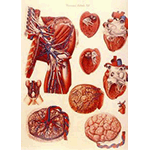Museo di Anatomia Umana del Dipartimento di Morfologia Umana e Biologia Applicata dell'UniversitÓ degli Studi di Pisa [University of Pisa Museum of Human Anatomy, Department of Human Morphology and Applied Biology]
The Museum, located in the Pisa School of Medicine and Surgery, at the Human Anatomy Section of the University of Pisa Department of Human Morphology and Applied Biology, was inaugurated on November 15, 1832 under the name of Anatomical Cabinet in a room of the "Anatomical Establishments" of the Santa Chiara Hospitals. The promoter of the initiative was Tommaso Biancini, "dissector and tutor in anatomy", but during the course of the century the Museum was significantly enlarged by the Pistoian physician Filippo Civinini, author of the first and most important catalogue of the collections. The "Anatomical Establishments", subject of particular attention in the nineteenth-century guides to the city, housed the prepared specimens utilized for research and was the site of the lessons taught in the scenographic and fascinating "Anatomical Theatre" by some of the leading figures in the Pisa medical school (Paolo Mascagni, Pietro Duranti, Filippo Civinini, Filippo Pacini, ad Guglielmo Romiti). In 1856 the collection already numbered 1617 pieces. In 1884 part of the pathological material was transferred to the museum of the new Institute of Pathological Anatomy.
The anatomical collection, dating from around the middle of the 19th century, includes several different groups: osteological (bones, entire skeletons of different human races, foetal skeletons, skulls), syndesmological (joints and ligaments), angiological (anatomical statues, prepared specimens pertaining to the heart and the blood vessels), splanctological (specimens prepared in formalin of the digestive, respiratory, nervous and urogenital systems) and embryological (foetuses and appendages of the foetus). It also contains anatomical models in wax and a set of extraordinary anatomical plates designed by Antonio Serantoni for the Anatomia Universale (Anatomia Universa XLIV tabulis aeneis iuxta archetypum hominis adulti accuratissime repraesentata) by Paolo Mascagni, published in Pisa starting in 1823. Mascagni's death mask, modelled in wax, is displayed in a glass case. Lastly, the museum has an archaeological collection with pre-Columbian material coming from excavations conducted by Carlo Regnoli between 1860 and 1870: mummies, skulls and grave goods consisting of utensils, fabrics and some hundred vases from the Chim¨ and Chancay cultures of the Peruvian coast, dating from the twelfth to the sixteenth century. Two Egyptian mummies are also exhibited.
****************************
Texts by Graziano Magrini
English translation by Catherine Frost
Last update 23/gen/2008




